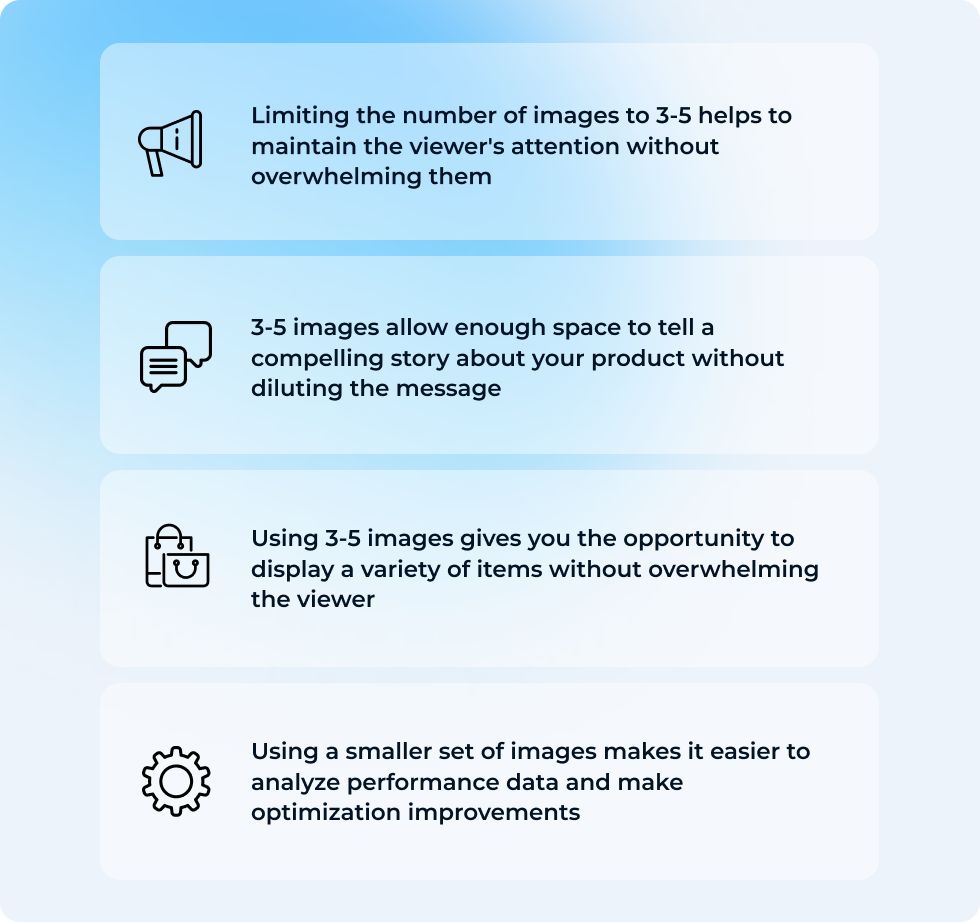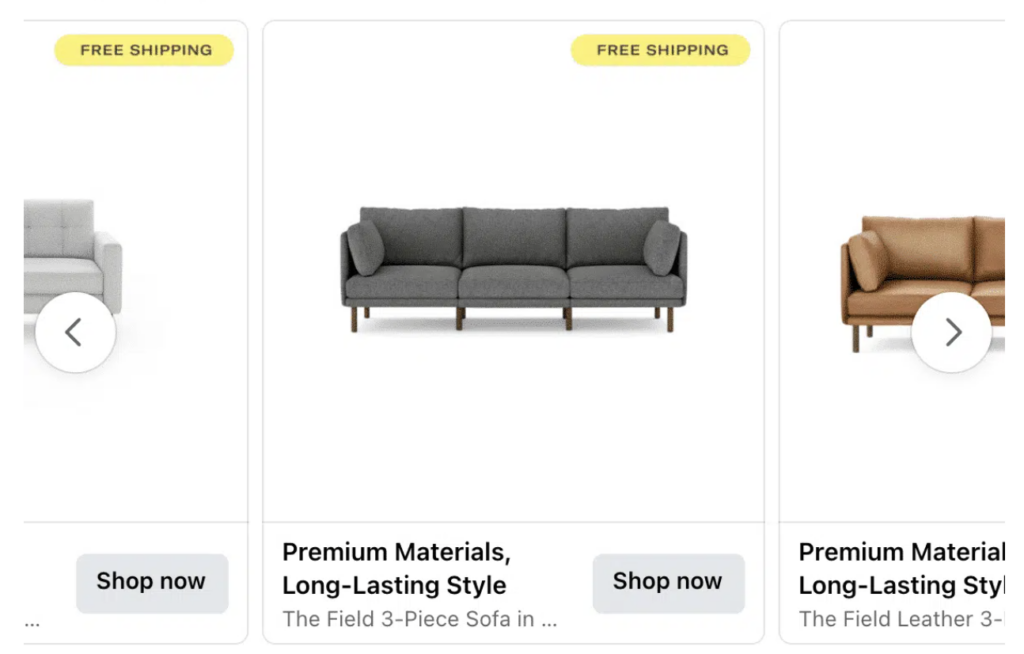Ever wondered about the impact of Carousel Ads on your Facebook campaigns?
In this blog post, we unravel the reasons why incorporating Carousel Ads is a strategic move.
Furthermore, we provide you with tried-and-true best practices to ensure your Carousel Ads leave a lasting impression.
Let’s optimize your approach and make those Carousel Ads work wonders for your marketing goals.
Understanding Facebook Carousel Ads
At the beginning, let’s see what Carousel Ads are.
So, Carousel Ads are a type of Facebook ad format that allow advertisers to showcase up to 10 images or videos within a single ad, each with its own unique link. It’s like having a mini-interactive catalog embedded within the Facebook interface.
Users can scroll through the carousel by swiping on mobile devices or clicking the arrow buttons on a desktop. This gives you an opportunity to tell a deeper story and engage your audience in a more interactive way.
Why Use Facebook Carousel Ads?
But why should you use Carousel Ads?
Well, the primary advantage of using Carousel Ads is the ability to deliver a more comprehensive and immersive experience to potential customers. They are particularly effective for showcasing a product range, highlighting product features, and telling a story.
With Facebook Carousel Ads, you can showcase a product range, highlight product features, and tell a story about your product.
- Showcasing a product range: Feature multiple products or services in a single ad, each with a separate link leading to its product page.
- Highlighting product features: Carousel Ads can be used to explain different features or benefits of a single product in detail.
- Telling a story: By sequencing images or videos, create a narrative around your brand or product, improving the emotional connection with your audience.
Facebook Carousel Ads Benchmarks and Performance
Although we now know what Carousel Ads are, to fully understand the effectiveness of Facebook Carousel Ads, it’s important to consider some key performance indicators.
So, let’s take a look at benchmark data that compares Carousel Ads with a Single Image and Video Ads on Facebook.
This analysis evaluates three different Facebook ad formats—Carousel Ads, Image Ads, and Video Ads—based on key advertising metrics: CPM, CTR, CR, CAC, and ROAS. Below is a breakdown of their performance and how they compare to each other.

Cost efficiency (CPM and CAC)
- Lowest CPM: Image Ads ($1.56)
- Highest CPM: Video Ads ($6.09)
- Lowest CAC: Carousel Ads ($15.47)
- Highest CAC: Image Ads ($27.97)
Image Ads are the cheapest in terms of cost per impression, making them ideal for brand awareness campaigns. However, their CAC is the highest, meaning they are less efficient at converting users into customers.
On the other hand, Carousel Ads strike a balance with a moderate CPM and the lowest CAC, making them the most cost-effective for customer acquisition.
Engagement and click performance (CTR)
- Highest CTR: Video Ads (0.98%)
- Lowest CTR: Image Ads (0.88%)
Video Ads drive the most engagement, likely due to their dynamic nature. Carousel Ads follow closely behind, suggesting that interactive content encourages more user interaction than static images.
Conversion effectiveness (CR & ROAS)
- Highest CR: Carousel Ads (1.39%)
- Lowest CR: Image Ads (1.26%)
- Highest ROAS: Carousel Ads (209)
- Lowest ROAS: Video Ads (138)
Carousel Ads outperform both Image and Video Ads in conversion rate and ROAS.
This indicates that showcasing multiple products or features within a single ad increases the likelihood of conversions.
Video Ads, despite having the highest CTR, generate the lowest ROAS, meaning engagement doesn’t always translate to profitability.
Which Ad Format is Best?
Best for cost-effective customer acquisition: Carousel Ads
They have the lowest CAC and highest ROAS, making them the most profitable format for driving sales.
Best for engagement & brand awareness: Video Ads
They generate the highest CTR but have a high CAC and the lowest ROAS, meaning they work better for top-of-funnel awareness rather than direct conversions.
Best for low-cost reach (but not conversions): Image Ads
They have the lowest CPM, making them the cheapest way to reach audiences. However, they convert the least efficiently, resulting in high CAC.
For e-commerce brands looking to maximize profitability, Carousel Ads are the best choice. Video Ads work well for awareness but need strong retargeting strategies, while Image Ads are cost-effective for reach but not for conversions.
How to Integrate Carousel Ads into Your Facebook Marketing Strategy
Implementing Carousel Ads into your marketing campaigns requires a strategic approach. The strength of Carousel Ads lies in their ability to showcase a variety of content, creating a broader, more immersive user experience.
Here are steps on how to effectively integrate Carousel Ads into your marketing strategy:
- start with retargeting ads,
- test different communication,
- showcase your product story,
- analyze and optimize, and
- expand to prospecting ads.
Start with retargeting ads
One of the most effective ways to introduce Carousel Ads into your campaigns is through retargeting. These are ads that target users who are already familiar with your brand—they’ve visited your website and browsed your products but haven’t made a purchase.
Because these users have shown interest in your brand, they’re more likely to engage with a Carousel Ad, allowing you to retarget potential customers and guide them back towards a conversion.
Test different communication
Use Carousel Ads to experiment with different messaging and narratives. Test a range of content from showcasing different product benefits to telling your brand’s story.
Use the multiple cards of a Carousel Ad to highlight different angles of your product or service, giving potential customers a more comprehensive view.
Showcase your product story
Unlike Single Image or Video Ads, Carousel Ads can provide a more detailed presentation of your product or brand story. Use each card to unfold a part of the story, creating a narrative that engages users and guides them through a journey that culminates with a call to action.
For instance, tools like Picsart can assist in creating compelling Carousel Ads by offering features like background removal that can help spotlight your product better.
Analyze and optimize
As you roll out your retargeting Carousel Ads, make sure to closely monitor performance metrics.
Identify which part of your narrative or which product feature resonate the most with your audience. Use this information to refine your ads and improve their effectiveness.
Expand to prospecting ads
Once you have a good grasp on what works best in your Carousel Ads, you can begin to use them in prospecting campaigns. Prospecting Ads target people who may not be familiar with your brand, so having a well-optimized Carousel Ad—armed with the lessons you learned from your retargeting campaign—will increase your chances of capturing their interest and driving them towards conversions.
By leveraging the unique storytelling capabilities of Carousel Ads and following these steps, you can effectively incorporate this dynamic ad format into your Facebook marketing campaigns.
Remember, Carousel Ads are not just about showcasing multiple products, they’re about telling a story that engages, informs, and eventually, converts your audience.
Are Facebook Carousel Ads worth it?
The value of Carousel Ads in your Facebook advertising strategy largely depends on your business goals and audience preferences.
Here’s why Facebook Carousel Ads are generally considered worth it:
- effective conversions,
- flexible and interactive,
- data-driven optimization, and
- cost-efficiency.
- Effective Conversions: Carousel Ads demonstrate superior conversion rates, outperforming Single Image and Video Ads by 20% and 25%, respectively, according to Lebesgue data.
- Flexible and Interactive: These ads offer a versatile platform to showcase diverse content and engage audiences through interactive storytelling.
- Data-Driven Optimization: They offer opportunities for data-driven optimization, helping improve future campaigns based on user interactions.
- Cost-Efficiency: Carousel Ads often result in lower cost-per-conversion and cost-per-click, making them cost-effective.
However, these ads require strategic planning, execution, and testing for the best results.
They may not suit every business or objective, but when used effectively, they can significantly enhance brand exposure, engagement, and conversion rates.
Potential Disadvantages of Facebook Carousel Ads
While Carousel Ads offer many unique advantages, it’s also important to consider some of their potential downsides, like complexity, content overload, and limited control over viewing order.
Potential disadvantages of Facebook Carousel Ads are:
- complexity,
- content overload, and
- limited control over viewing order.
- Complexity: Carousel Ads are more complex to create than Single Image or Video Ads. They require more content, whether it’s multiple images, videos, or different pieces of copy, which can lead to a more time-consuming creation process.
- Content overload: While the ability to showcase multiple products or tell a detailed story is a benefit, it can also lead to content overload. If the message is not clear or the sequence of cards is confusing, users may lose interest and scroll past your ad.
- Limited control over viewing order: Although you can set the order of the cards, Facebook’s algorithm can change the order based on engagement. This might disrupt the narrative if your ad is designed to be viewed in a specific sequence.
Optimizing the Number of Images in Your Facebook Carousel Ads
Choosing the ideal number of images for a Carousel Ad depends on your specific goals, the complexity of your message, and your audience’s attention span.
However, based on general best practices and user engagement patterns, using between 3-5 images tends to work well for most businesses regarding Carousel Ads.

For certain industries and products that rely heavily on visuals to capture attention and convey the value of their products, utilizing more elements in a Carousel Ad can be highly beneficial.
For example, in industries such as fashion, apparel, and jewelry, where the aesthetic appeal and design details of the products are important, the carousel format provides a platform to display multiple products or various angles and features of a single product.
This allows potential customers to virtually ‘experience’ products in a way that single-image ads cannot achieve.
For these sectors, using up to 10 images in a Carousel Ad can be very effective. It’s like having a mini digital catalog right within the Facebook interface.
However, this approach requires careful planning to ensure that each image contributes to the overall narrative and maintains the viewer’s interest. It’s also crucial to maintain high-quality imagery and compelling copy throughout the carousel to maximize engagement and conversions.
Summing Up
In conclusion, Facebook Carousel Ads are a valuable tool in the digital advertising toolkit, offering the ability to display multiple products or tell a detailed brand story within a single ad. Carousel Ads drive higher conversion rates, making them effective for conversion-focused strategies.
While not perfect for every campaign, Carousel Ads, when used strategically, can significantly boost brand exposure, engagement, and conversion rates. The key lies in aligning the ad strategy with your business goals, audience preferences, and refining your approach based on data-driven insights.




